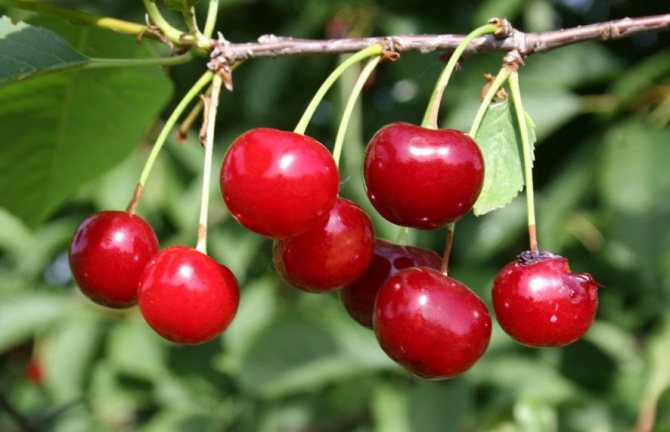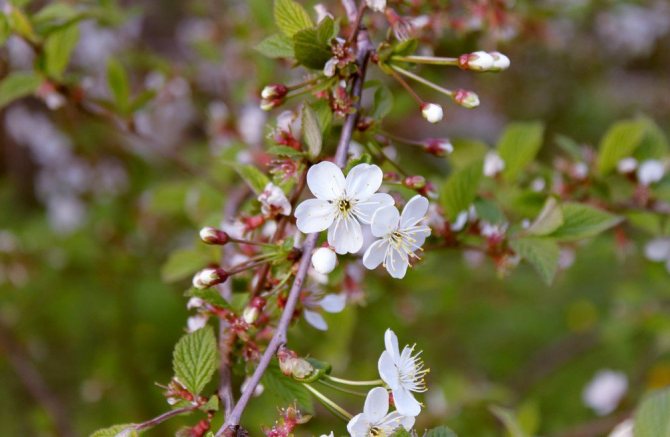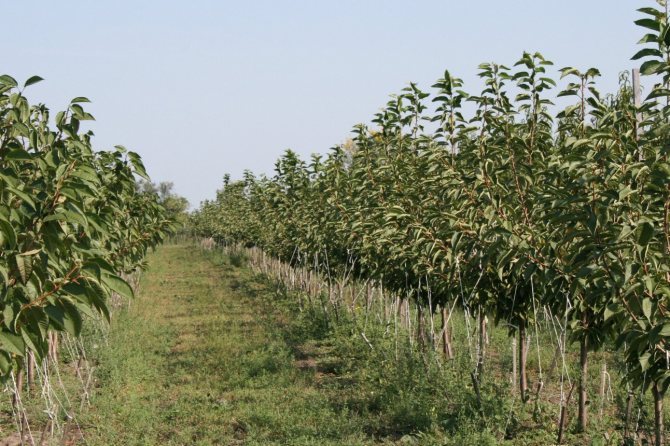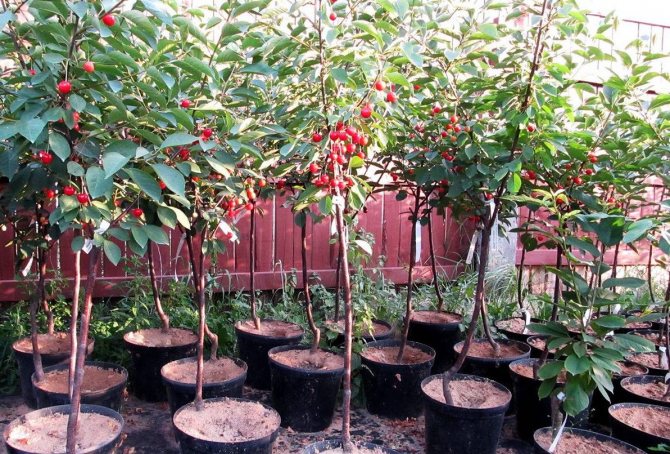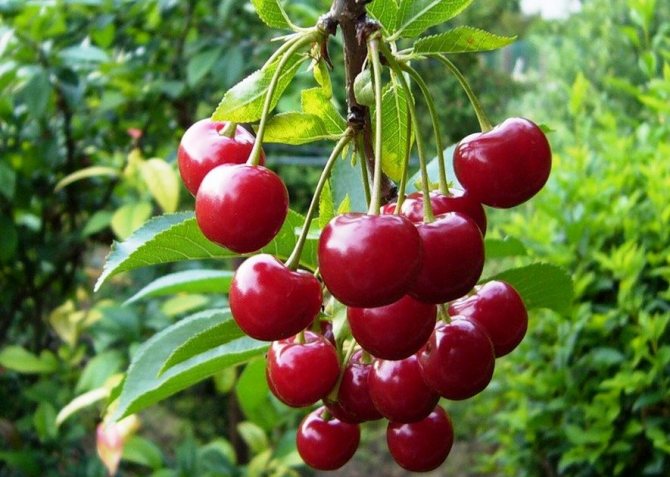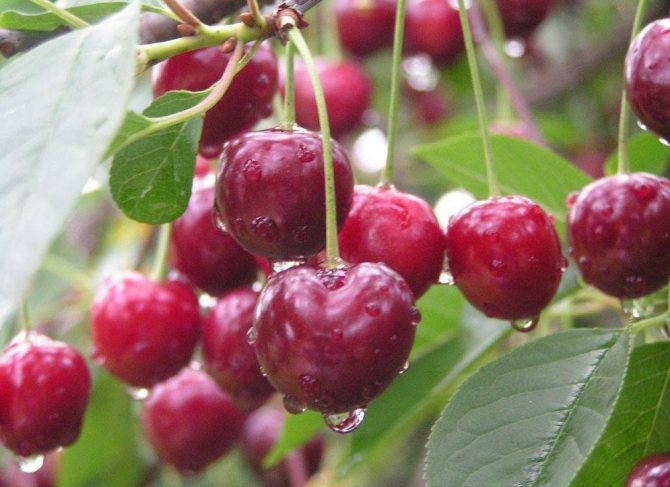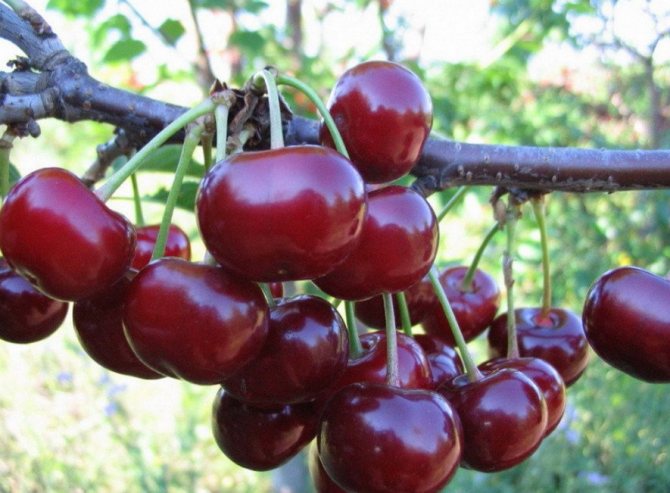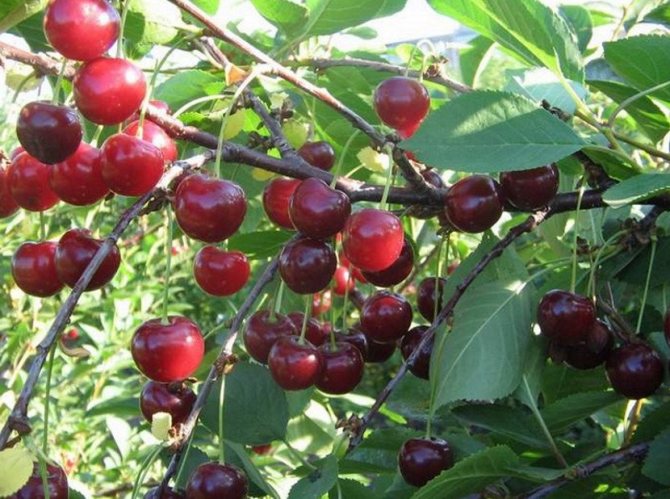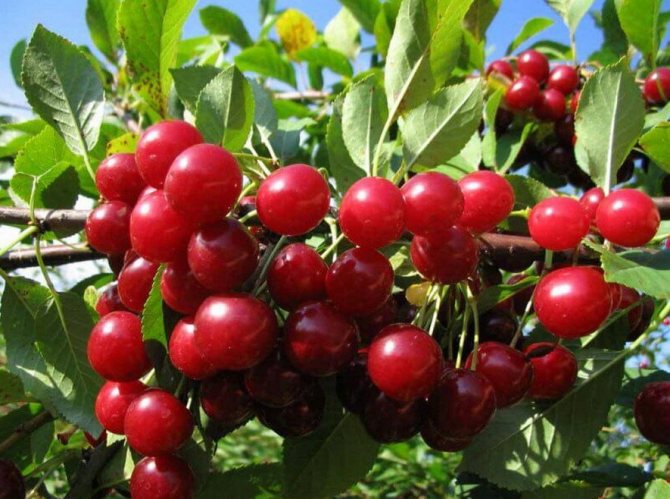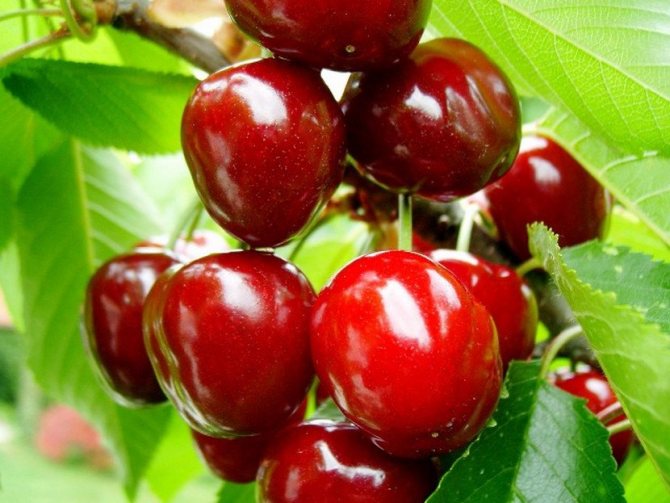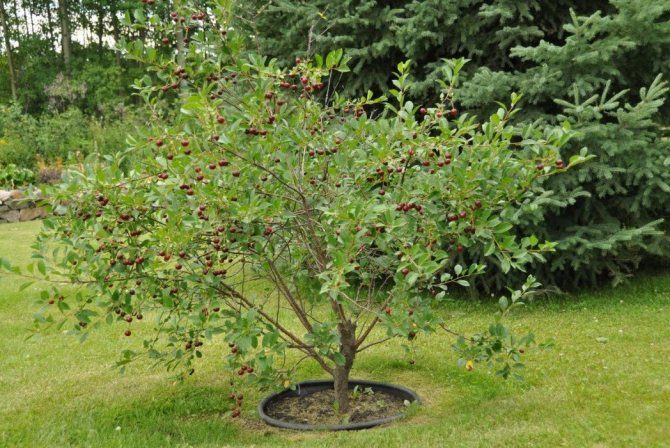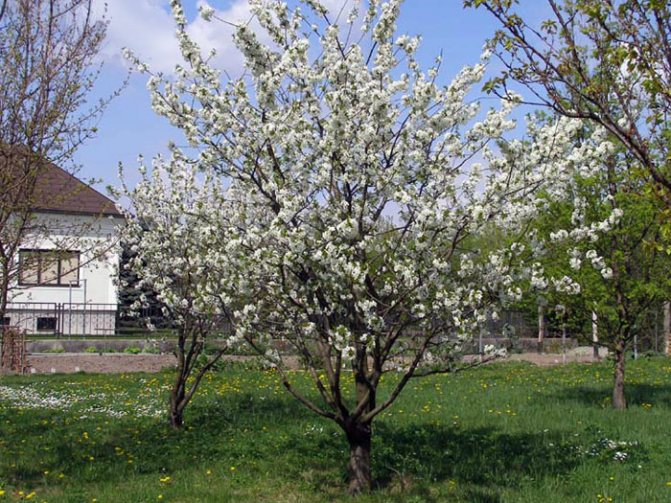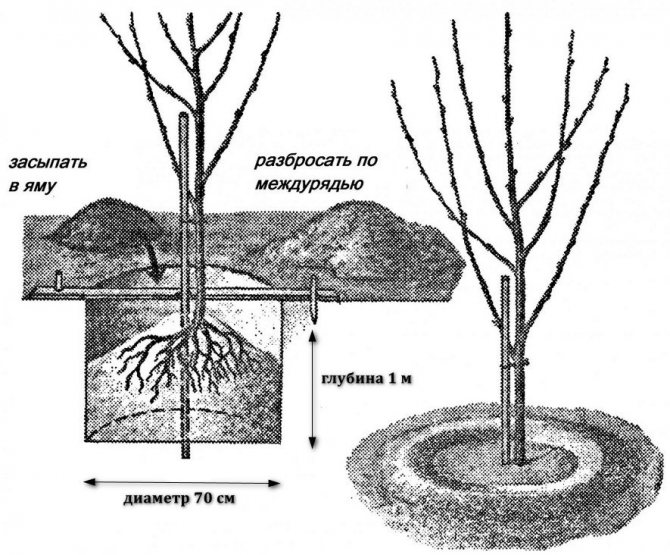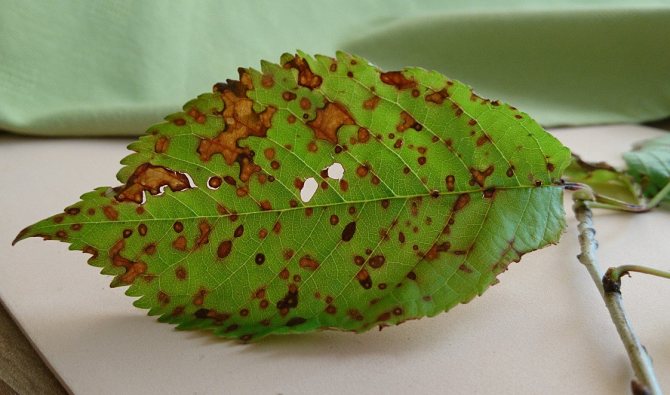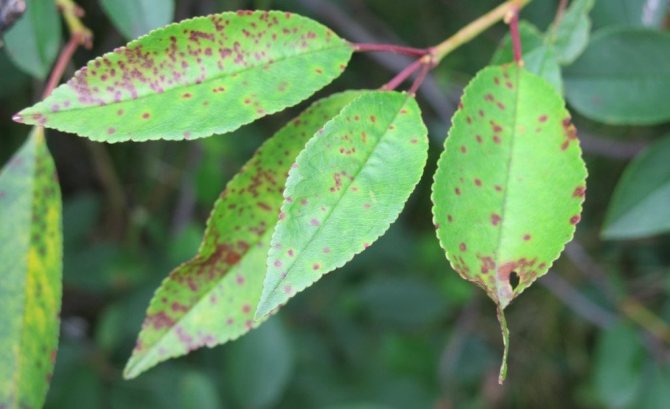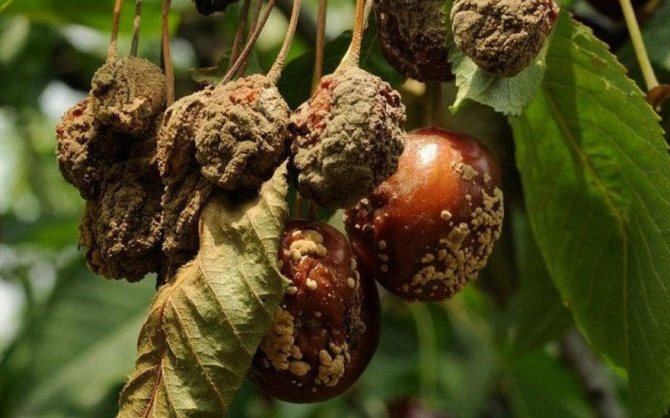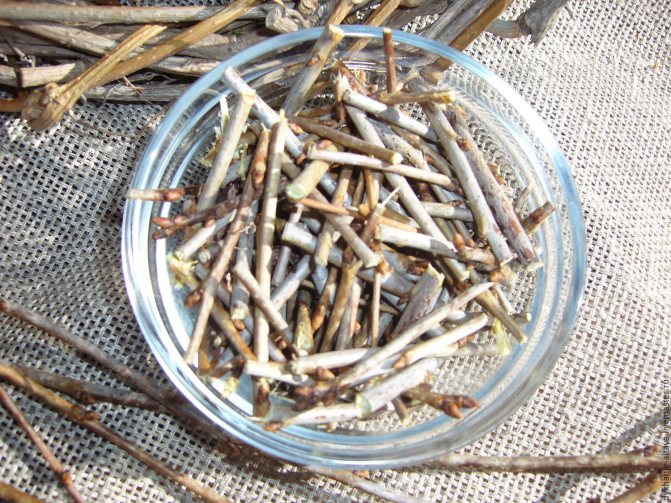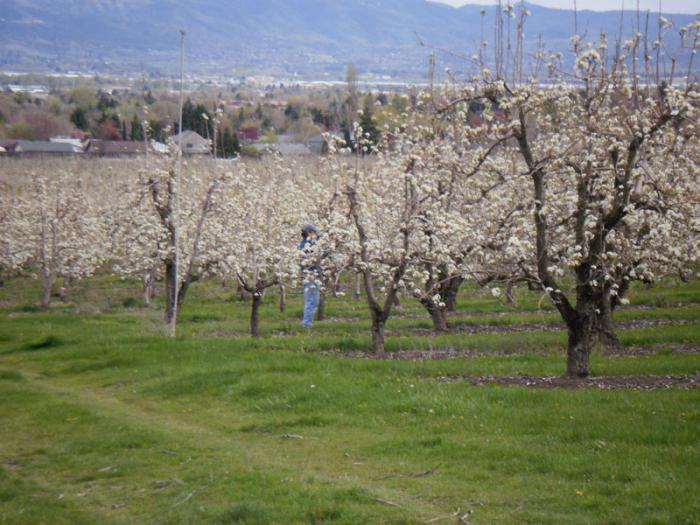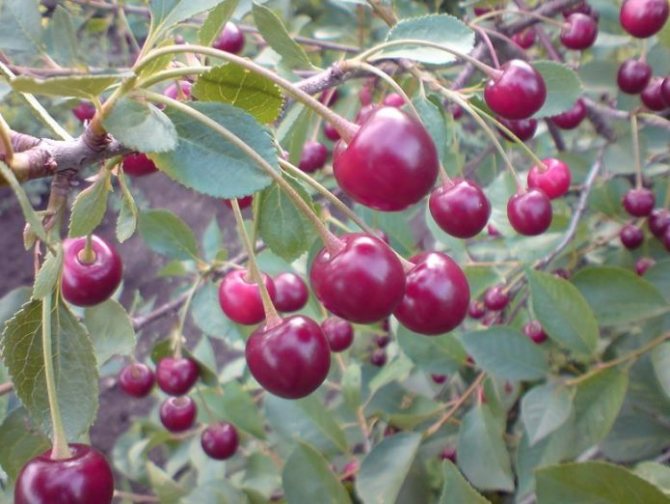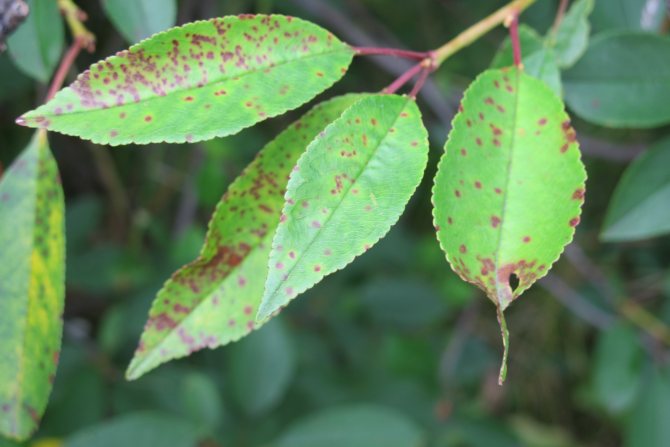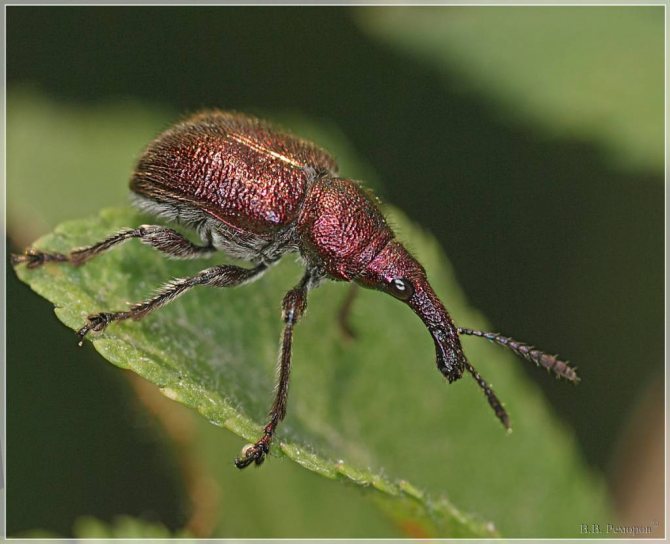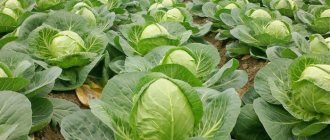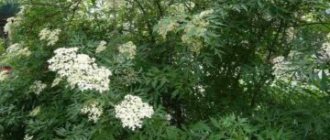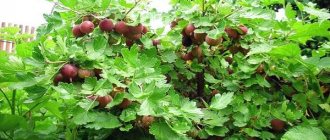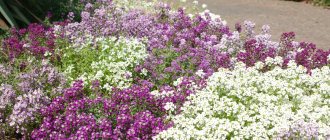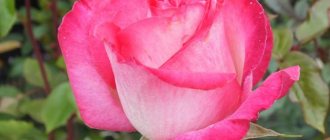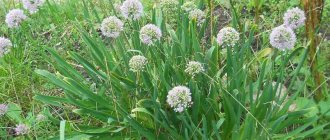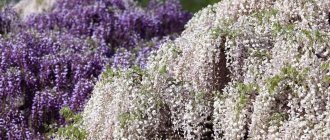- the main
- Cherry varieties recommended for planting in the Moscow region.
Sep, 18
no responses.
Say what you like, but the Moscow region can hardly be called an ideal place for growing fruit trees and berry bushes. Unfavorable climatic conditions sometimes lead to freezing of fruit crops. And lovers of cherry berries have to think about the choice of varieties when planting.
Cherry fruits are healthy and have a bright taste.
Nowadays, breeders have taken care of creating many zoned frost-resistant varieties. Cherry was no exception. In addition to climate resistance, breeding has awarded a variety of varieties and resistance to fungal diseases. In our article we will consider the most popular cherry varieties recommended for planting in the regions of the Moscow region.
How to choose a cherry for the Moscow region
Winter hardiness
Given the cold, and often just frosty winters, cherry varieties for the Moscow region should easily endure winter frosts and thaws, i.e. have good winter hardiness. It is desirable that both the tree itself and its flower buds be winter-hardy.
Winter-hardy cherry varieties for the Moscow region:
- Bulatnikovskaya,
- Volochaevka,
- Lyubskaya,
- Robin,
- Youth,
- Chocolate girl,
- Turgenevka,
- Fairy.
Disease resistance
Such dangerous diseases as coccomycosis, moniliosis, clasterosporosis, which have spread in recent years, bring great damage to cherry orchards. When choosing cherry varieties for the Moscow region, you should choose those varieties that are little susceptible to these diseases.
Most resistant to disease:
- Bulatnikovskaya,
- Morozovka,
- Radonezh,
- Silvia,
- Turgenevka,
- Fairy,
- Kharitonovskaya.
Self-fertility
During the cherry blossoms in the Moscow region, cold, rainy weather often happens when the bees do not fly and cannot pollinate the flowers. And, as a result, there is no harvest. Salvation in this case is to plant self-fertile varieties that can set fruits by pollination with their own pollen, without the help of insects.
Self-fertile cherry varieties for the Moscow region:
- Apukhtinkaya,
- Lyubskaya,
- Bulatnikovskaya,
- Volochaevka,
- Youth,
- Radonezh,
- Chocolate girl.
Yield
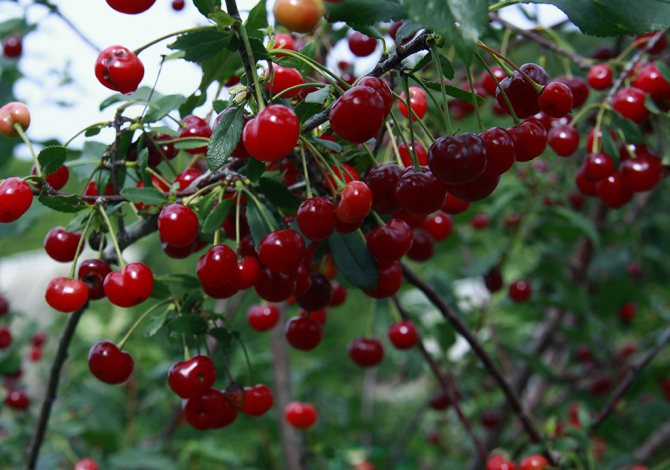
The harvest
By planting a cherry tree on our site, we expect to get good yields. They can be provided to us by:
- Apukhtinskaya,
- Volochaevka,
- Lyubskaya,
- Livenskaya,
- Robin.
Tree size
Cherry trees can be either tall or short. In a private garden, especially a small one, it is good to have short trees. They take little revenge and are easy to harvest.
Low-growing cherries for the Moscow region:
- Lyubskaya,
- Youth,
- Morozovka,
- Radonezh,
- Chocolate girl.
Ripening terms
By the timing of ripening cherries can be divided into early, middle and late. Most of all mid-season varieties.
Features of the garden in the Moscow region
The main problem for gardeners in the Moscow region is winter with winds and frosts. Therefore, trees can be planted here only with increased frost resistance and winter hardiness.
Attention! Frost resistance - the ability of a plant to withstand temperatures below -35 ° C. Winter hardiness is the ability of a plant to endure frosts, strong winds, icing and other climatic manifestations of winter.
For a cherry variety that will be planted in the Moscow region, it is very important to resist such fungi as moniliosis and coccomycosis. They are very common in this region, and the fight against them is carried out exclusively with pesticides.
The best cherry varieties for the Moscow region
Apukhtinskaya
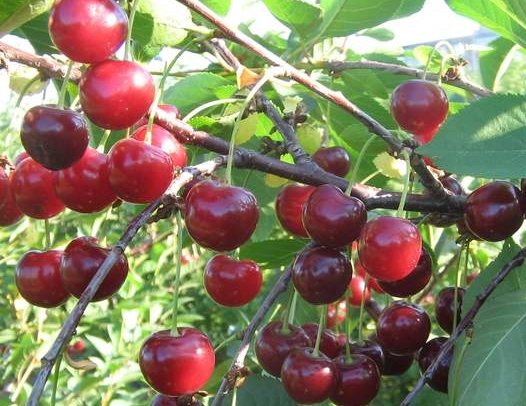

Apukhtinskaya
An old, but not losing popularity variety. Bears fruit abundantly and annually. Dark red, almost black fruits have a pleasant sour taste, ripen in July and August. They make a very good jam. The disadvantages include the average winter hardiness and susceptibility to coccomycosis disease.
Volochaevka


Volochaevka
One of the most reliable mid-season varieties zoned in the Central region. It regularly produces large yields of large fruits weighing about 4.5 g. They are dark ruby color, juicy, sweet and sour taste, with a delicate cherry aroma. This variety is self-fertile, it tolerates winter frosts well, the tree is of medium height. The susceptibility to diseases is average.
Robin
Dark red sweet sour fruits ripen in late July - early August. Winter hardiness is good in two respects: wood and flower buds. The tree is not very large (3–3.5 m), but every year it brings abundant harvests of berries. Disadvantages: has an average resistance to fungal diseases. The fruits are more suitable for processing.
Youth


Youth
A popular medium-ripening cherry variety obtained from crossing the old Russian varieties Vladimirskaya and Lyubskaya. Early, 3-4 years, brings the first harvest. Bears fruit annually and abundantly. The berries are large and tasty. Among the advantages of Molodezhnaya, one should also note such qualities as self-fertility, short stature and winter hardiness of the tree. The disadvantages include the weak resistance of flower buds to the spring cold and only average resistance to moniliosis and coccomycosis.
Lyubskaya
An ancient variety of cherries of national selection. Ripens late, in August. It is popular due to its qualities such as self-fertility, the early onset of fruiting: it bears the first berries for 3-4 years, low tree growth, high and annual yield. Disadvantages: susceptibility to fungal diseases, sour taste of the fruit.
Radonezh
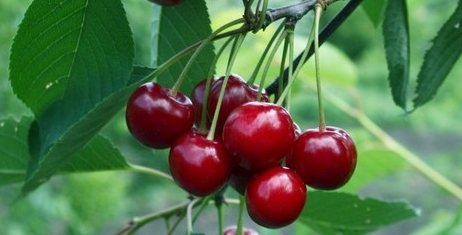

Radonezh
This variety, bred by the Bryansk breeders A.A. Astakhov and M.V. Kanshina is not as well known to gardeners as he deserves. A short tree tolerates cold winter temperatures well. From the fourth year it brings harvests of dark red berries of good sweet and sour taste. Fruits are medium-large in size, weighing 4-4.5 g. Radonezh is partially self-fertile and, which is very important, has good resistance to major fungal diseases. The disadvantages include the average yield.
Turgenevka
Large-fruited, winter-hardy cherry variety, widespread in gardens near Moscow. It ripens in medium terms: early-mid-July. Quite resistant to coccomycosis and moniliosis. The tree is small, up to 3 m high, is not afraid of drought, it recovers well after freezing. Good harvests every year. The berries are large, very juicy, and have a pleasant taste.
Chocolate girl
Low cherry with dark red tasty fruits. Self-fertile, with good winter hardiness of wood and buds. The tree is 2-2.5 m high, drought-resistant, begins to bear fruit in 4 years .. The disadvantage is susceptibility to coccomycosis and moniliosis, average yield.
Dwarf cherry varieties for planting in limited areas
Unfortunately, not all residents of Moscow and the Moscow region can boast of extensive summer cottages. But do not despair, especially for those whose plot is small in size, breeders bred dwarf varieties of cherries loved by all. Among them, worthy positions are occupied by the following:
- "Anthracite" - fruits are purple to black, fleshy and juicy;
- "Mtsenskaya" - in appearance with an oval crown;
- "Bystrinka" - quickly grows and bears fruit;
- "Tamaris";
- "Rusinka".
Anthracite Rusinka Mtsenskaya
Landing
Plots
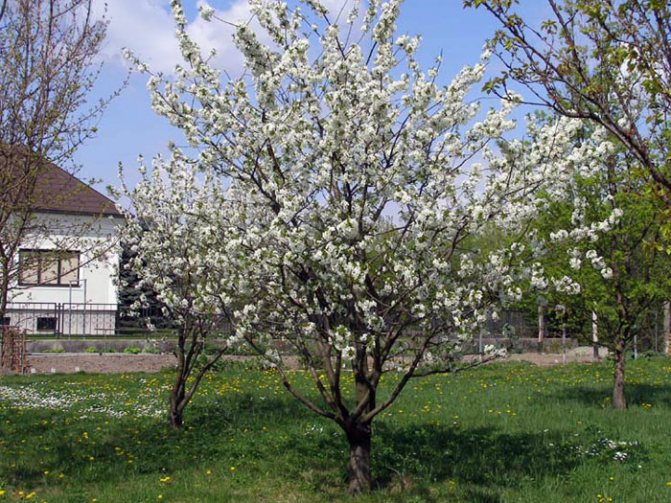

In the garden
For planting cherries, select areas that:
- are on a dais,
- well ventilated,
- illuminated by the sun,
- protected from cold air currents.
Unsuitable for growing cherries:
- lowlands, hollows;
- places with a close occurrence of groundwater (closer than 2 m).
The soil
The most suitable soil for a cherry orchard is light to medium loam with neutral acidity. On heavy clay soils, you need to add sand, carry out liming (add lime at the rate of 0.5 kg per 1 square meter).
Boarding time
In the Moscow region, the best time for planting cherries is spring. Since cherries, like all stone fruit crops, begin to wake up early, seedlings with an open root system should be planted as early as possible - as soon as the snow melts. Autumn planting is undesirable. It is better to dig in the seedlings bought in the fall obliquely and leave them to winter under the snow until spring. Plants with a closed root system, i.e. in pots, you can plant the entire warm season until frost.
The presence of pollinating combs
When planting a cherry orchard, you should take care of the presence of pollinator varieties
Since most varieties of cherries are self-fertile or partially self-fertile, then, in order to obtain good yields when planting, it is necessary to use several varieties, among which there will be universal pollinators. This is useful even for varieties that are considered self-fertile, as they produce large yields in the presence of pollinators.
Varieties and varieties of zamioculcas of the species zamielistny (with photo)
Zamioculcas zamielistny (Z. zamiifolia);
Zamioculcas lanceolate (Z. lanceolata);
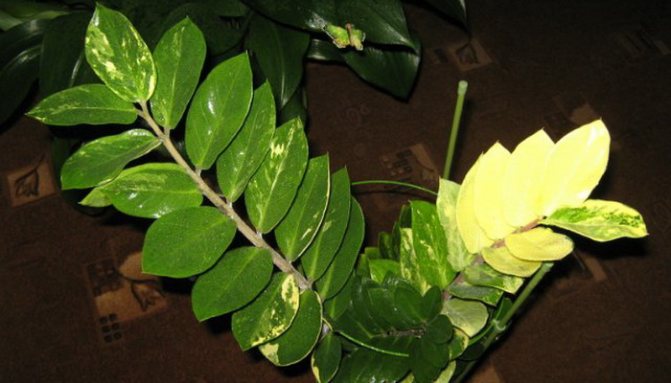

Zamioculcas variegated (Z. variegated).
It is interesting for novice plant breeders to know how zamiokulkas blooms in nature and at home? The flowering of zamiokulkas in nature is a rare phenomenon, since it happens only at a very mature age. In room culture, under appropriate conditions of maintenance, good care, the plant blooms with white and light cream flowers, but already at a fairly old age.
The inflorescence is an ear. Flowers of different sexes are located separately on the cob, female - from below, male - from above, and between them there is a zone of sterile flowers. Due to this structure of the inflorescence, its self-pollination is impossible. In nature, the succulent is pollinated by the wind or by crawling insects that live in the plant's homeland.
The photo shows how the zamioculcas blooms: inflorescences consisting of an ear and a veil, which appear at the very base of the leaves at a very old age of the plant.
In room culture, the zamioculcas flower is quite unpretentious, and how to care for it is described below. In order to provide zamiokulkas with favorable growing conditions, you should know the features of the environment of its existence.
Zamioculcas requires bright diffused light, but it also tolerates partial shade, therefore it grows well on the northern window. With a sufficient amount of light, it grows faster and retains the brightness of its colors. In a dense shade, the growth rate of zamiokulkas will slow down, the leaves will weaken, and there will be fewer of them on the trunk.
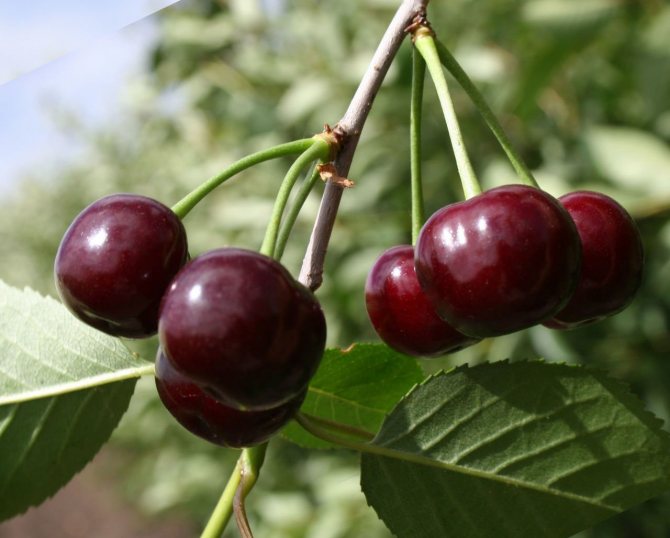

Zamioculcas can withstand a wide range of temperatures, but this plant is thermophilic and does not feel well in cool rooms. Grows best in a warm room with bright, diffused lighting, moderate watering and occasional spraying. The optimum temperature for a dollar tree in summer is 20-26 ° C.
As for other succulents, air humidity for zamiokulkas does not play a big role. Zamioculcas does not require leaf spraying, it is adapted to dry climates. But to maintain beauty, sometimes the plant needs to "take a warm shower" in order to get rid of the dust settled on the leaves, this procedure should not be repeated more often than once a month.
The dollar tree thrives in moderately nutritious, porous soil. Good drainage is a must. The most optimal is the composition of a mixture of sod land, sand and expanded clay, which, if necessary, can be replaced with fine gravel. Of course, a commercially available universal soil is considered the best option, but if you decide to prepare the mixture yourself, then the substrate is prepared from leafy earth, peat, humus and sand (1: 1: 1: 1). If the mixture is homemade, it is recommended to disinfect it. This can be done by sprinkling with boiling water, or igniting in the oven.
Caring for a zamioculcas flower at home is not burdensome, subject to a number of simple rules.
Watering. The main rule for watering zamiokulkas at home is moderation. The plant can be poured, so you need to water it carefully. The fact is that its tuber absorbs moisture, which is necessary for normal development and growth. Thanks to this accumulation, this flower survives drought. Therefore, it is better to underfill than to overfill.
It should be remembered that zamioculcas must be watered only as the soil dries out. Between waterings, the top 2-3 cm layer of the earth should dry out. In summer, watering frequency is 2 times a month, in winter - 1 time per month. It is recommended to defend water for irrigation.
An improper watering regime can cause many plant diseases, as well as cause harmful insects to appear on it. With insufficient watering, the plant loses small leaves, when overdried, all the leaves may fall off, when overflowing, the leaves turn yellow and the roots rot. In the latter case, the plant will be difficult to save.
Top dressing. To ensure the normal development of the plant, during the growth period, feeding is carried out with a complete mineral fertilizer, which must be alternated with organic fertilizer. It is better to fertilize zamiokulkas in a complex way than with one type of fertilizer, because the alternation of mineral and organic fertilizers will allow you to grow a large plant sooner.
The feeding period runs from mid-March to mid-September. To do this, use a liquid fertilizer for succulents and cacti. This fertilizer does not contain nitrogen particles and has a slightly lower concentration than other fertilizers. The frequency of feeding is once a month, from April to August - 2 times a month. In winter, it usually does not need feeding.
Zamioculcas grows slowly, new leaves appear at long intervals. Older leaves at the bottom fall off naturally. The massive fall of the leaves indicates improper care.
In order for the plant to grow and develop well, you need to know how to care for zamiokulkas in a pot. Therefore, the transplant is preceded by the choice of a pot for the plant. The flower grows best in flowerpots commensurate with the size of the root system (growth accelerates when the roots reach the walls). If the roots of a plant begin to emerge on the surface of the soil, then it needs to be transplanted into a slightly larger flowerpot.
Before planting zamiokulkas, you need to properly prepare the composition of the soil. The soil for zamiokulkas should be loose and porous. Sand or perlite is added to it by at least a quarter of the volume. Good drainage is essential. At the bottom of the pot, drainage is made from expanded clay, also by a quarter. For better development of a plant in a new pot, its tuber must not be completely lowered into the ground.
Due to the small root system, the flower grows slowly, so young plants should be transplanted no more than once a year, slightly increasing the volume of the pot, and adults - no more than once every 3-5 years. It is better to plant zamiokulkas in the spring. It is necessary to work with rubber gloves, as the plant sap is poisonous.At home, transplanting zamiokulkas in the spring allows the tubers to better acclimate and quickly build up green mass.
The question of how to properly cut a zamioculcas can be heard quite often. With normal development, the plant does not need pruning, it forms its own crown. Zamioculcas are pruned when they want to rejuvenate the old leaves that have become woody in the lower part, or simply give a certain shape to the plant. If, due to improper growth, it is necessary to cut off the zamiokulkas for better nutrition of the branches, it is best to do this during the period of active growth - in the spring.
Below are the most common zamioculcas diseases and how to treat them.
Destruction of the root system. During this disease, the flower practically does not grow. This is due to overflow, which is the greatest danger to the plant. Watering was too frequent or the sump was not supplied with water. This disease leads to the death of the dollar tree. The only way out of the situation is to cut off the cuttings and root them in the newly prepared soil.
Dark spots on the trunk. Appear due to improper plant care. To eliminate stains, you need to revise the care regimen.
Shrinking of the stem when there is a lack of water. Another cause of this disease may be soil hardening. It is necessary to loosen it and ensure the plant is properly watered.
Often there is a problem when the leaves of zamiokulkas turn yellow, which can be caused by the following reasons:
- Natural aging, due to which only the lower leaves turn yellow and fall off. At the same time, new leaves appear on the top of the plant. This is a normal, natural process that does not depend on care.
- Sudden changes in temperature. In this case, the plant has a massive yellowing of the leaves. It is necessary to check whether the flower is standing in a draft and whether a cold stream of air falls on it.
- The wrong watering regime causes yellowness on young leaves.
- Dry indoor air leads to yellowing and drying of the tips of the leaves. It is necessary to occasionally spray the plant with warm water.
A succulent of unusual beauty rarely suffers from parasites; they are frightened off by a thick peel that protects the zamioculcas. But sometimes it can be affected by such pests: scale insects, spider mites, aphids. If you find insects, you should treat the leaves of the plant with warm soapy water. If this remedy does not work, special preparations are used to eliminate this kind of parasites.
The most common fruit diseases
The damp climate of the Moscow region contributes to the spread of such dangerous fungal diseases of cherry as coccomycosis, clotterosporosis and moniliosis.
Coccomycosis


Coccomycosis
In case of coccomycosis, the leaves are covered with brown spots, and depressed brown spots appear on the fruits. Such fruits are tasteless and often dry out. With a strong development of the disease, the leaves turn yellow and fall off early, which leads to the weakening of the tree and its freezing in winter.
Clasterosporosis
Clasterosporosis
Clasterosporosis or perforated leaf spot. It affects all parts of the plant. Small brown spots appear on the leaves, which grow and holes form in their place. Cracks appear on the branches and resin flows out of them. The fruits stop growing and dry up.
Moniliosis (or monilial burn)
Monilial burn
The first signs of the disease appear immediately after flowering. Affected flowers darken and dry out. Further, the disease spreads to leaves and shoots. They also turn brown and dry out. The wood takes on a burnt appearance. The fruits rot. The branches affected by the disease dry out.
Observance of correct agricultural practices, mandatory spring treatment of the garden from diseases, removal of diseased and dried branches and fruits, as well as the correct choice of cherry varieties for planting will help to overcome these dangerous diseases and get good harvests annually in the gardens of the Moscow region.
Cherry is the most popular berry in Russia. This tree can be found in almost every garden and yard. The northern part of Russia is also rich in cherry orchards, but for successful fruit picking it is necessary to choose the best cherry varieties for the Moscow region.
Seedlings with resistance to weather conditions
The breeders did not forget about the development of new varieties that would firmly endure the weather conditions of the central part of Russia, Siberia and the Urals. In the auspices of such varieties, the following are worthy of special attention:
- "Molodezhnaya" - a wide openwork crown and short stature make it easy to pick fruits;
- "Malinovka" - bright red fruits with a rich sour taste;
- "Griot" is a vigorous tree that can bear fruit for over 20 years;
- "Shubinka" is a weeping variety with falling branches, abundantly strewn with berries.
Robin Youth Griot
What should you look for when choosing a variety for the Moscow region?
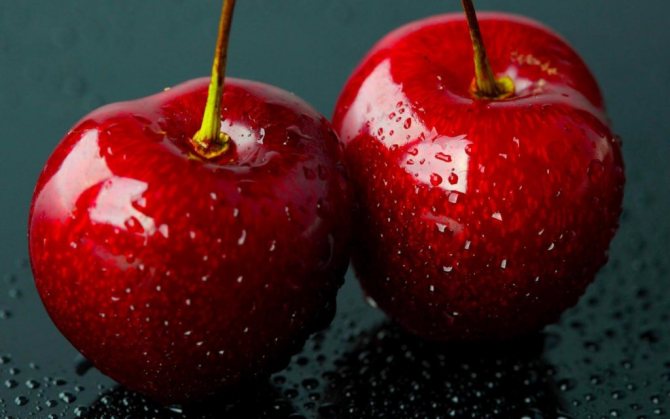

Planting a cherry tree is not difficult, but whether it will take root is the main question. The gardener is obliged to understand the varieties and growth conditions of the tree, correlate them with his climatic zone and then make the purchase of seedlings.
The main points when choosing a cherry variety for planting in the Moscow region:
- Climatic features. The harsh winter climate can kill the cherry tree. The Moscow region is characterized by icing and frosts down to -35 ° C. Therefore, cherries must have winter hardiness and frost resistance. The most winter-hardy varieties of cherries: Lyubskaya, Molodezhnaya, Shokoladnitsa, Turgenevskaya, Malinovka, Feya.
- Diseases characteristic of the region: coccomycosis (yellow leaves) and moniliosis (berries become covered with white spots and rot), clasterosporiasis. Therefore, it is important to choose cherry varieties that are resistant to coccomycosis and monoliosis. Affected trees are treated only with chemicals. The most disease-resistant cherry varieties: Turgenevskaya, Feya, Silva.
- Self-fertility is the ability to bear fruit “alone”. Since the Moscow region is characterized by rainy and cool summers, bees suspend their activities. Pollination becomes a problem for bountiful harvests. In this case, self-pollinated varieties without the help of insects are needed. Self-fertile varieties of cherries: Apukhtinskaya, Lyubskaya, Shokoladnitsa, Radonezh.
- Productivity. A high level of yield is the goal of any gardener. Cherry varieties with abundant harvest - Lyubskaya, Apukhtinskaya, Malinovka.
- Ripening terms. Usually cherries are mid-season. However, there are both early and late ripening varieties.
- The size of the tree. Cherries are both tall and short. Most gardeners choose undersized varieties for easy harvesting. Low varieties of cherries: Molodezhnaya, Lyubskaya, Shokoladnitsa.
A little about early bush varieties
Despite the fact that summer in Moscow can hardly be called early, and residents of southern countries are already indulging themselves with cherry fruits, there are specialized early varieties for Russians. Among them stand out favorably:
- "Cherry" - fast growth and fruiting in the 3rd year of growth;
- "Shpanka Bryanskaya" - with large juicy fruits with sourness;
- "Sania" - a tree with a spherical shape;
- "Crimson" - abundant fruiting with sweet fruits;
- "Zhivitsa" is a varietal plant with a shape in the form of a ball.
Zhivitsa Shpanka Bryansk Sania
The best cherries for the Moscow region
Cherry varieties that meet the listed characteristics of choice for planting in the Moscow region: Lyubskaya, Apukhtinskaya, Turgenevka, Molodezhnaya, Shokoladnitsa, Malinovka, Feya, Silva, Radonezh, Volochaevka.
"Lyubskaya"
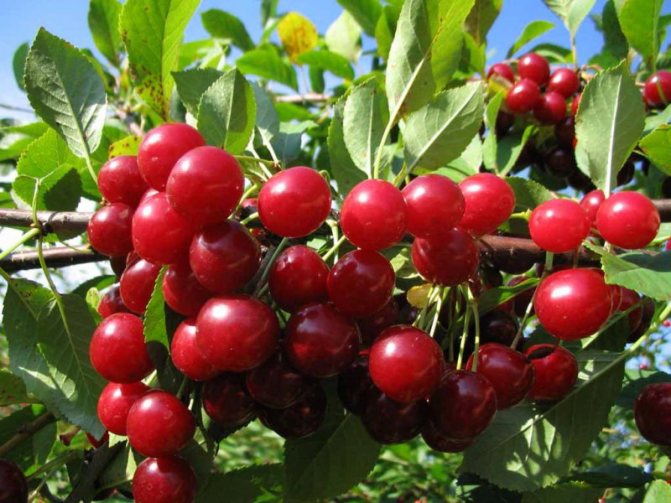

The main advantages of this variety:
- Frost resistance and winter hardiness.
- Resistant to common cherry diseases.
- Possibility of easy and affordable harvesting due to the low growth of the tree (no more than 3 m).
- Simple tree care (dense, voluminous crown).
- Harvesting is possible as early as 2 years after planting.
- The transportation is well tolerated by the berries.
Cons of the variety:
- Thin bark.The tree needs shelter, as it can get damaged in severe frosts.
- Cherries do not take root on soils with high acidity. To avoid this factor, the soil must be sprinkled with lime before planting.
Lyubskaya cherry has a voluminous crown and branches with an arc shape. The height of the tree is 3 m. The bark with small cracks is brown with a grayish tint. The taste of the berries is sour, the color is bright red. The shape of the berries is round, the size is medium (4 g).
Productivity - up to 40 kg per tree. There have been cases of harvesting from one tall tree up to 35 kg. This variety is ideal for cooking compotes and preserves.
Cherries are capable of bearing fruit on their own. Harvesting is possible the next year after planting the seedling. By about 9 years old, the tree bears maximum fruit. Cherry depletion occurs 20 years after planting.
This variety responds well to organic feeding. Frequent chemical fertilization should be avoided. The seedling must be watered moderately so that the roots do not rot and the water does not stagnate. It is imperative to remove dried branches and shoots.
"Apukhtinskaya"
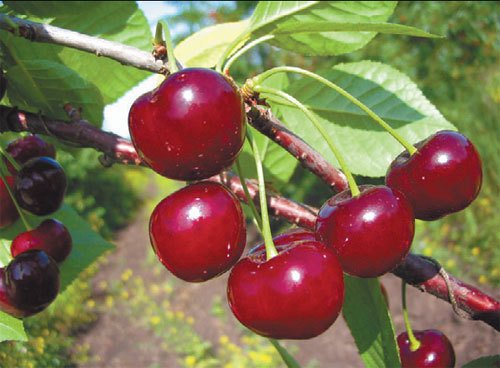

The main advantages of this variety:
- Frost resistance and winter hardiness.
- Resistant to common cherry diseases.
- Possibility of easy and affordable harvesting due to the low growth of the tree (about 2 - 3 m).
- Simple tree care (bush shape).
- Harvesting is possible as early as 2 years after planting.
Cons of the variety:
- Not suitable for cross-pollination.
- Late harvest is fraught with loss of fruit if an early cold autumn comes.
Apukhtinskaya cherry has the shape of a bush. The height of the tree is 2 - 3 m. The taste of the berries is sour with a slight shade of bitterness, the color is dark red. The shape of the berries is "heart".
Cherries are capable of bearing fruit on their own. The tree blooms in June. Harvesting is possible the next year after planting the seedling at the end of summer.
It is better to plant Apukhtinskaya cherry on the south side of the garden, in the autumn, in a sunny place. Planting will be successful if you choose a two-year-old seedling. The best place would be land with no groundwater.
This variety is the most successful for planting in the Moscow region. The tree must be periodically fertilized and cut off dried branches and shoots (leave 5 shoots on the crown). You can feed cherries when planting, both organic and chemical fertilizers. In general, feeding is needed once every 3 years.
Watering cherries infrequently, but during dry periods, the amount of water can be increased.
"Turgenevskaya"
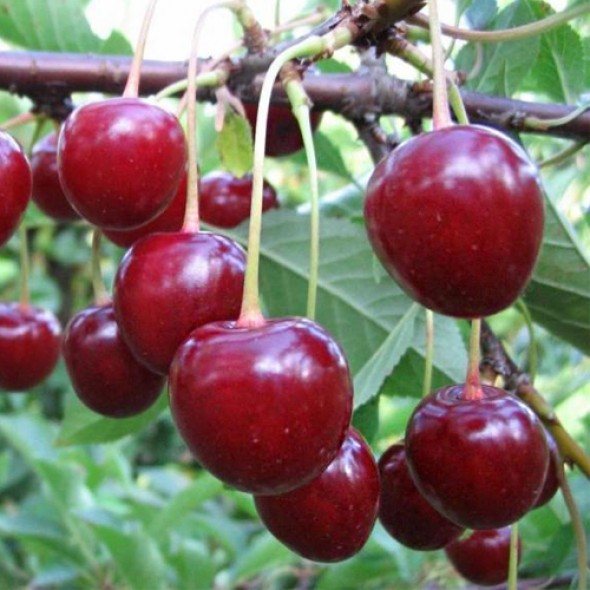

The main advantages of this variety:
- Frost resistance and winter hardiness.
- Resistant to common cherry diseases.
- Possibility of easy and affordable harvesting due to the low growth of the tree (no more than 3 m).
- Large fruits (6 g).
- High yield level.
- The transportation is well tolerated by the berries.
Cons of the variety:
- Low self-fertility rate. Necessary "neighbors" like Lyubskaya cherry.
- Fruits appear only 4 years after planting.
- Spring frosts are dangerous when buds appear.
The Turgenev cherry is shaped like an inverted pyramid. The height of the tree is about 3 m. The taste of the berries is sweet (if the beginning of summer was sunny with heavy rains), the color is red. The shape of the berries is round, large fruits (6 g). Cherry has a high yield (about 25 kg per tree).
Cherry fruits ripen in early July. During this period, more frequent watering is desirable.
Planting a tree is best in elevated places. Cherry pruning is required once a year to thin the crown. In winter, the tree must be covered to ensure better conservation. In spring, frosts are dangerous if buds have already appeared on the branches.
"Youth"
The main advantages of this variety:
- Frost and winter hardiness.
- Resistant to common cherry diseases.
- Possibility of easy and affordable harvesting due to the low growth of the tree (about 2.5 m).
- Bountiful harvest.
Cons of the variety:
- Fungal infections are possible in humid and hot summers.
- Spring frosts are dangerous when buds appear.
The form of youth cherry is bush. The height of the tree is about 2.5 m. The taste of the berries is sweet and sour, juicy, the color is bright red. The shape of the berries is round, the size is medium (4 g). Productivity from 1 tree - up to 40 kg. This variety is suitable for both everyday snacking and preservation.
A bountiful harvest is harvested at the end of July. It is best to plant cherries on a hill in a place well-lit by the sun. Suitable soil is neutral, sandy. Pruning dry branches is required annually. Watering is moderate, without excess, in order to avoid stagnation of water in the soil, leading to decay of the roots. In winter, sheltering the cherry tree will be helpful.
"Shokoladnitsa"
The main advantages of this variety:
- High level of frost resistance.
- Possibility of easy and affordable harvesting due to the low growth of the tree (about 2.5 m);
- Self-fertile.
- It tolerates drought well in summer.
- Bountiful harvest.
Cons of the variety:
- Fruiting not earlier than 4 years after planting.
- Not resistant to coccomycosis and monoliosis.
- Spring frosts are dangerous when buds appear.
The shape of the "Shokoladnitsa" crown is an inverted cone. The height of the tree is 2.5 m. The taste of the berries is sweet with sourness, the color is maroon. The shape of the berries is slightly elongated, the size is medium (3.5 g). The stone is easily separated due to the soft pulp. The yield from a tree is about 12 - 15 kg.
An early variety due to which ripening is possible already at the beginning of July. Watering is rare as the variety has a high level of drought tolerance. However, during flowering, the amount of water for irrigation can be increased. The seedling should be planted on the south side of the garden. The tree should not be shaded, it is better to provide a sunny place.
"Robin"
The main advantages of this variety:
- Average level of frost resistance (including kidney).
- Late ripening.
- Bountiful harvest.
Cons of the variety:
- Self-infertile. Planting next to other pollinating trees is required. An excellent "neighbor" will be Lyubskaya cherry.
- Unstable to monoliosis.
- Small size of berries.
The shape of the "Robinovka" crown is spherical. The height of the tree is 3.5 m. The taste of the berries is sweet and sour, the color is dark red. The shape of the berries is round, the size is small (3.5 g). Productivity from a tree is about 12 - 14 kg. The berries ripen in mid-August. The variety is ideal for preparing compotes, preserves, jams and pies.
The robin will successfully "take root" on loose soils on the southern or southwestern side of the garden. The planting of pollinating varieties is obligatory nearby. Avoid groundwater near the surface of the earth. Cherry care is simple: periodic pruning, timely watering and fertilization.
"Fairy"
The main advantages of this variety:
- Convenient harvesting due to the low growth of the tree (about 2 m).
- Average level of frost resistance.
- Resistant to fungal diseases.
- Bountiful harvest.
Cons of the variety:
- Fruiting for 4 years after planting.
- Small size of berries.
The shape of the Fairy's crown is spherical. The height of the tree is 2 - 3 m. The taste of the berries is sweet with a sour tint, the color is light red. The shape of the berries is oval, the size is small (3.5 g). Productivity from a tree is about 10 - 12 kg. The berries ripen at the end of June. The fairy bears its first fruits quite late (4 years after planting).
The cherry variety does not like acidic soils. Before planting, it is advisable to process the land with liming. If there is close groundwater, it is necessary to create a drainage system.
"Silvia"
The main advantages of this variety:
- Resistant to frost.
- The transportation is well tolerated by the berries.
Cons of the variety:
- Low level of resistance to diseases characteristic of cherries.
- The yield is below average.
- Small berry size (about 2 g).
Silva is tapered. The height of the tree is about 3 m. The taste of the berries is sour, the color is red.The shape of the berries is round, the size is small (2 g). Cherry has a low yield (about 12 kg per tree). Often, this variety is used for cooking compotes and jam.
Cherry fruits ripen in early July. It is necessary to plant a tree on a hill. Cherry pruning is required once a year to thin the crown. In winter, the tree must be covered to ensure better conservation.
"Radonezh"
The main advantages of this variety:
- Good resistance to low winter temperatures.
- Tolerates spring frosts.
- Partial self-fertility (40%).
- Resistance to coccomycosis and monoliosis.
Cons of the variety:
- The first harvest is possible 4 years after planting the seedling.
- Average yield level.
Crohn "Radonezh" has an oval shape. The height of the tree is from 3 m. The taste of the berries is sour with a slight hint of sweetness, the color is deep red. The shape of the berries is round, the size is medium (4 g). Productivity - 15 kg from one tree. The first berry picking is possible at the end of June.
Cherry "Radonezh" belongs to the dessert varieties. Great for fresh consumption, as well as for making cherry juice.
The "Radonezh" variety requires good lighting. Planting should be carried out in elevated areas so that groundwater does not come closer than 1.5 m to the surface of the earth. Sub-sandy, neutral soil is suitable, which is permeable to moisture and air.
"Volochaevka"
The main advantages of this variety:
- High level of winter hardiness.
- Self-fertile.
- Resistance to coccomycosis and monoliosis.
Cons of the variety:
- The first harvest is possible 4 years after planting the seedling.
- Small fruits.
The height of the tree is from 3 m. The taste of the berries is sweet and sour, the color is dark red. The shape of the berries is round, the size is small (2.7 g). Productivity - 12 - 15 kg from one tree. Berries are picked at the end of July. Perfect for fresh consumption, as well as for making preserves, jams.
The choice of a cherry variety suitable for planting in the Moscow region remains with the gardener. Therefore, it is worth considering all the factors affecting the yield of the tree.
Cherry Apukhtinskaya
Cherry Aptukhinskaya. Cherry belongs to the late varieties. The fruits ripen in the second decade of August. This cherry also blooms later than other varieties, in early June. This feature should be taken into account when planting a number of self-fertile cherries. Apukhtinskaya cannot be used as a pollinator.
Description Cherry Apukhtinskaya. The height of the tree is up to 300 cm. This is its maximum height. But at the same time, such a cherry is quite spreading. Its crown is usually drooping. If desired, it can be made in the form of a bush, which will greatly facilitate harvesting. A distinctive feature of this variety is that the seedlings after planting begin to bear fruit already in the second year, and the yield increases every year. Annual branches also bear fruit. Fruits, in comparison with other varieties, have a darker red color, which can sometimes acquire a brown tint. The fruit of the Apukhtinsky variety is larger than that of an ordinary cherry. Their weight can reach 3.5 g, and in some cases even 4 g. The peculiarity of the fruits of this tree is that they have an unusual heart-shaped shape, and their flesh is very juicy and always looks great. The juice also has an intense dark red hue. Berries contain a lot of free acids and sugar. A medium-sized oval bone is characteristic. The variety is self-fertile. Disease resistance is high. Average frost resistance. Therefore, the variety is suitable for cultivation in the southern and central regions. Winter hardiness zone 5 (-29 С)
Cherry. Deciduous trees or shrubs with oblong-ovate leaves; white, sometimes pink fragrant flowers, collected in umbrella-shaped inflorescences. The fruit is drupe, juicy, mostly edible, red or black. Most of the species are cultivated for food and medicinal purposes.Due to their high decorative effect during flowering and fruiting, they can be widely used in ornamental gardening.
Place for planting cherries. For planting cherries, an elevated area with a good air regime and drained soil is suitable. It is best to land on slopes with a steepness of 7-8 °. In flat areas, cherries develop worse and more often fall under frost. The western, northwestern and southwestern slopes, due to their inherent moderate humidity and sufficient thermal stress, create the best conditions for growing cherries in most areas of central Russia. For cherries, soil acidity, texture and moisture are very important. The reaction of the soil medium must be strictly neutral, or at least very close to it (pH 6.5-7.0). Even on slightly acidic soils, cherries do not grow well, bear fruit worse and often freeze out. In this case, obligatory liming is required one year before planting. Local application of lime materials directly into planting pits or trenches simultaneously with planting sharply impairs the survival rate of seedlings. Low and damp places with a summer level of groundwater occurrence within 2 m from the soil surface for planting cherries, and even more so sweet cherries, are unsuitable. Moreover, the farther north the area, the harder it is to follow this requirement when choosing a site for cherry culture. In relation to the mechanical composition, cherry prefers light and medium loams, heavy clays are not suitable for it without appropriate preliminary cultivation.
Planting cherries. Cherry seedlings are planted in the open ground in early spring. In autumn, planting is also possible, however, young plants do not always have time to take root before the onset of frost. Before planting, the seedlings are carefully examined, damaged shoots are removed, the roots are shortened and dipped in a clay mash. Planting pit dimensions: width - 70-80 cm, depth - 50-60 cm. The top layer of soil removed from the pit is mixed with rotted manure or humus, wood ash and lime (with increased soil acidity). Complex mineral fertilizers are also added to the soil mixture.
Cherry care. Cherry culture needs irrigation and additional watering only in areas of insufficient moisture. In severe drought, watering is necessary after the formation of the ovary (late May - early June) and the laying of flower buds of the next year's harvest (late July - early August). In any case, abundant watering ends 3-4 weeks before harvest, otherwise the fruits will crack and their quality will be worse. Of the elements of mineral nutrition, cherry reacts sharply to a lack of nitrogen and potassium in the soil and, to a lesser extent, to a deficiency of phosphorus. However, all norms of organic and mineral fertilizers should be applied depending on the level of soil fertility. On poor soils, the approximate recommended dose of manure (humus or compost) is 8-10 kg / m2, on medium -4-6 kg / m2. Mineral fertilizers (phosphorus and potassium} are best applied in a dose of 18 g of active ingredient per 1 m2 in accordance with its content in this type of fertilizer. At higher doses of organic fertilizers, the norms of mineral nutrition are reduced by 2 times.
Cherry pruning. Regardless of when you plant your cherries (in spring or fall), the first pruning is done in the spring. At the sapling, five of the most developed and strong branches are left (in bushy branches, up to ten branches are allowed to be left), the rest are removed without leaving the hemp, and the wounds are immediately covered with garden var. It is desirable that the branches left be directed in different directions and located at a distance of at least 10 cm from each other. This is the first post-planting cherry pruning so that other branches do not take away the growth force from the main branches.
Pruning rules in subsequent years:
- from the second year, the main task of pruning, in addition to forming the crown, is to prevent thickening of the bush. To do this, all branches growing inside the crown will need to be cut out, and the shoots that appear on the trunk should be broken off in the summer, while they are green, or cut out next spring;
- in tree varieties, branches that grow strongly upward are pruned so that the tree does not turn out to be too tall;
- on bushy cherries, shoots that have reached a length of more than 50 cm are shortened;
- as the cherry grows, new skeletal branches will need to be left on the trunk in order for the crown to form correctly - as a result, the main branches should be 12-15;
- Cut out damaged and dried branches every year.
Using cherries. Cherries are used raw, canned and dried. Compotes, jelly, jams, syrups, tinctures, various drinks, fruit drinks, fruit water are prepared from the fruits. The leaves are used for pickling and pickling cucumbers and other vegetables. Cherry berries contain sugar (fructose, glucose), organic acids (citric, malic, lactic, succinic, salicylic, chlorogenic), pectin and tannins, macronutrients (calcium, potassium, magnesium, phosphorus), trace elements (iron, copper), enzymes , anthocyanins, vitamins C, B2, PP, P, carotene, folic acid, inositol, coumarins. Cherry is of great importance for beekeeping, being a good honey plant. It can be used as an ornamental plant in forest and group plantings, hedges.
Subtleties of care
Cherry is a strong and unpretentious tree. For abundant fruiting, she needs a moderate amount of moisture, nutritious neutral soil and timely pruning.
Important! Sanitary pruning for cherries is relevant annually, and the removal of branches for the purpose of rejuvenation is recommended every 4 - 5 years.
Watering
Most cherries tolerate drought well and react painfully to dampness. Therefore, it is unacceptable for water to stagnate in the tree trunk hole, but it still needs periodic watering.


Experts advise to moisturize the soil under the plant abundantly:
- during its flowering period;
- when the ovary is formed (to prevent its shedding);
- after harvesting (moisture is necessary for laying future fruits).
Under each adult tree, you need to pour no more than 3 liters of water. Excess moisture contributes to the development of root rot and fungal infections. During the fruiting period, excessive watering can provoke cracking and rotting of the berries.
Did you know? The name "cherry" is of Slavic origin. He is associated with "height", "the Almighty". For many peoples, this tree is considered divine and symbolizes life.
.
Top dressing
Fertilizing cherries is important every 2 to 4 years. Nitrogen-containing, potassium and phosphorus mixtures will be useful during the flowering period of the tree. (It is important to feed at the beginning of budding and 2 weeks after that). The working solution is prepared in a 3: 2: 1 ratio.


If in the spring, when the seedling was rooting, the site was not properly prepared, then in the spring the young tree must be fed with organic substances (rotted humus or compost).
Experienced gardeners advise pouring fertilizer into the near-stem hole under young cherries, and fertilizing adult trees by spraying nutrients throughout the garden. The frequency of feeding for young cherries depends on their annual growth. For example, if in 12 months the length of the side branches has increased by 60 cm, then no measures need to be taken.
If the increase is much less, then in the spring a mixture of:
- half a bucket of humus;
- 100 g double superphosphate;
- 150 g of ammonium nitrate.
We recommend that you familiarize yourself with the features and methods of feeding cherries.
Trees that are more than 4 years old need a mixture of:
- 20 g of ammonium nitrate;
- 10 g double superphosphate;
- 5 g of potassium salt.
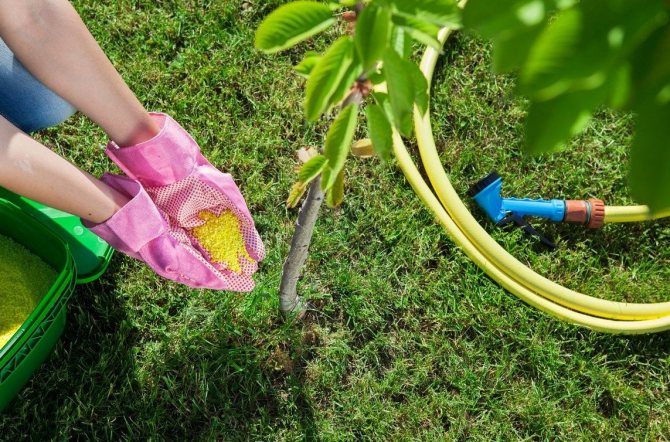

In the first years of life, it is important to observe the development of a young seedling. Its appearance suggests the presence or excess of certain substances. Namely:
- Intensive biomass growth, highly elongated shoots and low yield - a sign of an excessive amount of nitrogen-containing components in the soil. With its lack, an unnatural yellow speck appears on the leaves.
- Prematurely yellowing, dying foliage - a signal about the need to reduce phosphorus components. In the case of their deficiency, the curvature of the fruit is observed. They taste excessively sour, the foliage loses its gloss.
- Weak growth, partial death of branches, pale green foliage with traces of necrosis, its twisting, small fruits - it is worth reducing potash fertilizing.
- Leaf spot, development of chlorosis, appearance of light streaks - signal about excess amount of microelements
Important! Cherries are sensitive to attacks of moths, mucous sawfly, caterpillars, aphids, goldtail, hawthorn, weevils. To get rid of pests, spraying the tree with an insecticide solution is required
.
Pruning
Cherries need annual sanitary and periodic rejuvenating pruning. For the full development of the tree and in order to prevent its diseases, it is important to remove damaged, broken and dried branches from the crown every spring. The place of the cut must be treated with garden varnish to prevent gum leakage.
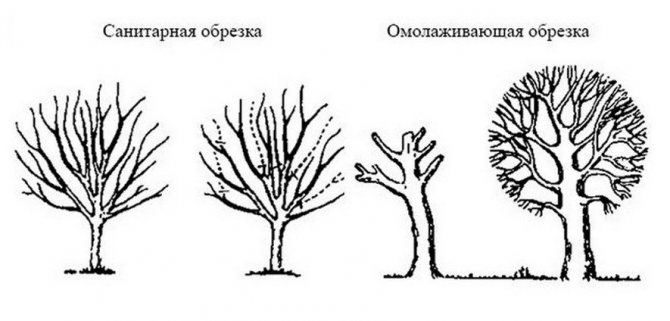

It is also important to remove the shoots growing inside the crown. For abundant fruiting, all branches should be well lit. It is recommended to plan pruning in March, when there is no threat of frost, but the tree is still dormant.
We advise you to learn about measures to combat gum flow on cherries.
Preparing the tree for winter
Young trees require special attention. To stimulate winter-hardy qualities in autumn they are watered abundantly. It is important that by this time the trunk circles have already been dug up (15 cm deep), otherwise moisture stagnation will lead to damage to the roots. After that the holes are mulched with sawdust, mown grass or peat. Needles cannot be used as mulch, since this material contributes to the oxidation of the soil.
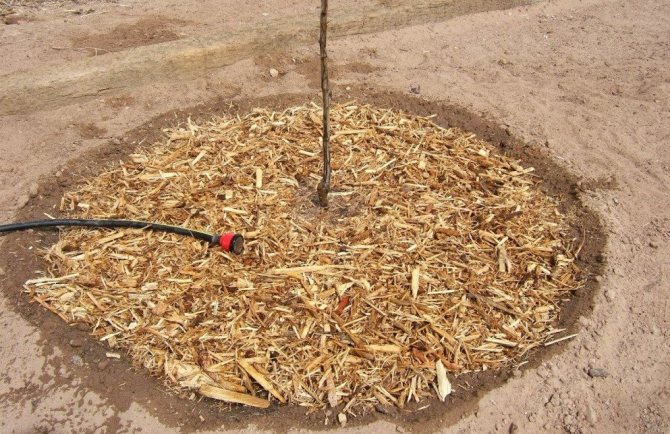

At the stage of autumn preparation for cold weather, all trees need to be prevented from diseases. To start you need to carry out sanitary pruning and remove fallen leaves from the garden. Then experienced gardeners advise spray trees with 5% urea solution. In order to help the cherry to winter safely, you can cover it with snow by tamping it tightly in the near-trunk circle. In snowless winters, dry straw or hay will come to the rescue.
Planting cherries in the fall: instructions for the gardener, the order of work
Cherries are my favorite horticultural crop. She normally tolerates medium frosts, droughts, and is unpretentious in care. By the way, you can plant cherries including in the fall - I will tell you about the advantages and features of this method further.
Pay attention to preventive measures to prevent the appearance of fungi - this is especially important in high humidity conditions.
There is no consensus among gardeners about when is the best time to plant cherries. There are different options, each of them has its pluses and minuses. When choosing a season, take into account the climate in the region, the varietal characteristics of the selected plant. It is important to calculate the planting time correctly - return frosts should be bypassed.
Cherries are usually planted in autumn until mid-October. If the air temperatures are stable and are about 10 degrees, the culture will have time to take root normally. The growth of the vegetative mass will begin in the spring.
In the fall, it is easier to purchase a seedling with a strong root system, and it will cost less than in the spring after long-term storage. In terms of development, autumn trees are ahead of their spring counterparts by an average of 3 weeks.
Watering is practically not needed - there is enough natural precipitation.The main disadvantage of the autumn procedure is the high risks of freezing of soils and roots, damage to seedlings by rodents is possible.
Diseases and pests
| Coccomycosis and moniliosis Stages of the struggle:
|
| Cherry weevil Stages of the struggle:
|
Care rules and preparation for wintering
If the summer is dry, there is practically no rainfall, a watering hole is made around the tree. With the appearance of frost, it is filled up in order to avoid the formation of stagnation of liquid, waterlogging of the soil. The trunks are mulched with sawdust or peat until a sharp cold snap, then the seedling is spud 25-35 cm.
The branches must be tied to the embedded stake using a soft cloth. For strapping the trunk, a warm material is used that does not allow air to pass through, a mesh is placed on top, a dense layer of spruce branches is organized.
To scare off rodents, a mixture of clay with a mullein in equal proportions is used. The layer should be thin. With the onset of spring, weaning is carried out, the prevention of planting from fungus, viruses. Pruning the conductor of young crops and each branch by about a third is required, the procedure is done while the buds are dormant.
This regulates the ratio of the aboveground and root parts of the plant. If everything is done correctly, cherries will take root well, take root, and acquire a high resistance to diseases. Regular prophylaxis does not provide 100% protection against infections, but significantly reduces the risk of diseases, strengthens plants.
Planting a cherry tree sapling in the fall is not difficult, but it is important to follow all the rules. Think over each stage, calculate the timing, do not forget about shelter for the winter - and the garden will soon begin to delight you with excellent harvests.
Cherry varieties for the Moscow region
Which self-fertile cherries are undersized?
We recommend reading our other articles
- Melon variety Altai
- Rabbits of breed Butterfly
- Harvest varieties of cucumbers
- The best varieties of large plums
Low-growing trees or shrubs have become very popular in the last 5-10 years. They are easy to deal with: harvest, prune, spray, etc. Self-fertile cherry varieties are no exception. The following are small varieties that are easy to grow in almost any climate.
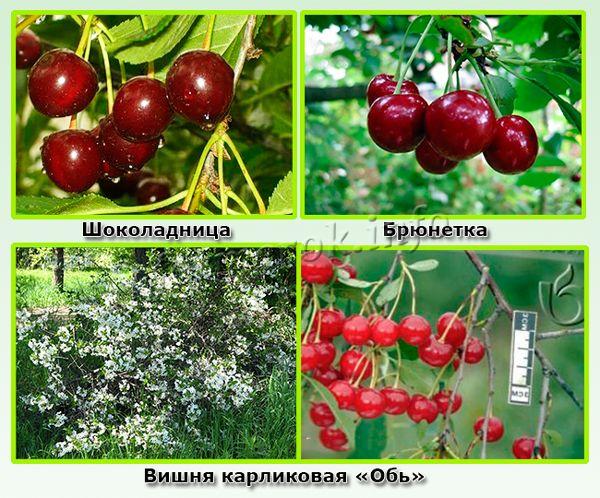

Low-growing self-fertile cherries
- "Shokoladnitsa" Is a self-fertile mid-early variety, the tree of which grows up to 2-2.5 meters. The crown is compact, reverse pyramidal, not very dense. The flowers are white, with about 3 flowers in the inflorescence. Berries up to 3.5 g, rounded. The color of the peel is almost black, the flesh is dark red. The stone is round, it separates well. Cherries are very tasty, sweet (sugars 12.4%, acids - 1.64%), tasting score - 4.3 points out of 5. Productivity - 77.9 centners / ha.
- "Brunette" grows up to 2.5 meters, spreading crown. The berries are dark red, up to 3.8 g, maroon. The taste is sweet and sour, juicy, the pulp of a delicate consistency. The variety ripens in the 20th of July. Has a universal application. Productivity 10-12 kg / tree.
- "Ob" grows up to 1.5 m maximum. The crown is large, up to 1.6 m in diameter. Berries up to 4 g, dark red, heart-shaped with a blunt end. The pulp is light red, juicy, sweet and sour. Sugars in the composition up to 12.1%, acids - 1.4%. Recommended for processing, as it is not very tasty when fresh. The variety is mid-season, has good winter hardiness, drought resistance. Productivity up to 3.8 kg / bush. The main disadvantage is that it is often affected by coxomycosis.
Cherry classification by pollination method
When purchasing a seedling, you need to know that an abundant color alone does not guarantee a good harvest. Without pollination, less than 20% of flowers will reach the fruit stage.Fruiting exceeding 50% can only be obtained with a paired pollinator. Depending on its type, two large categories of cherries are distinguished: self-fertile and self-fertile varieties.
Self-infertile is the type of cross-pollinated crop that is capable of setting fruits only when adjacent to a plant of another variety, which plays the role of a pollinator.
Self-fertile is a variety for which a growing tree of the same variety can become a pollinator nearby.
For both categories, there is a rule for planting trees in arrays of three or four pieces, preferably a whole garden. For a dozen self-fertile trees of the same variety, it is recommended to take at least one plant of a different variety with the same flowering period. In this case, due to the ingress of pollen of another variety on the pistil of a flower, you will receive the maximum number of ovaries (the norm for self-fertile varieties is pollination up to 40-50%, in the presence of other varieties - 10-15% more).
Self-fertile cherry varieties include the following:
- Apukhtinskaya;
- Lyubskaya;
- Zagoryevskaya;
- Chocolate girl;
- Bulatnikovskaya;
- Brunette;
- Youth;
- Assol;
- Volochaevka;
- Memory of Yenikeev.
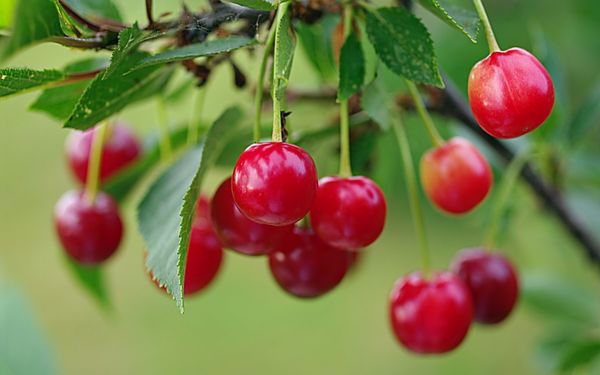

Cherry Lyubskaya is a typical representative of self-fertile varieties
It is believed that self-fertile varieties are self-sufficient, and they do not require insects or cross-pollination, neither cold weather nor hot heat are terrible. This is partly true. In practice, the garden bears fruit more richly where it is diluted with another variety.
Classification


Now we will briefly consider the features of the varieties of ordinary cherries, steppe and Bessei (sandy). You can read more about them in other articles on our site, as well as about varieties of felt cherries.
Most of the information can be obtained in the tables, where the culture is broken down by the timing of fruiting. Note:
- Varieties with other fruiting periods are often used as pollinators. This is due to the flowering time - for cherries, from the moment the buds open until the harvest, the timing varies.
- If the variety is intended for the southern regions and is frost-resistant there, one should not hope that it will withstand the low temperatures of the Urals or the Moscow region.
- The yield column often says “from the bush” or “from the tree”. This reflects the woody shape of the cherry.
- If you do not have the ability or desire to process plants after flowering, choose cherry varieties resistant to coccomycosis and moniliosis.
Early ripe cherry varieties
These cherry varieties are the first to bear fruit.
Basic rules for growing cherries
In Russia, cherries were called "the berry of paradise"; in many icons, Jesus Christ is depicted with cherries in his hands - a symbol of life, joy and fertility.
To avoid mistakes when growing cherries, you must follow the following rules:
- Buy seedlings only in reliable nurseries:
- Choose self-fertile varieties and know their specific characteristics;
- Do not plant seedlings close to each other, cherries do not like shade;
- Provide wind protection;
- Places with a close occurrence of groundwater are not suitable for cherry trees;
- Carry out treatment with drugs for fungal diseases and pests;
- Water and feed trees several times per season;
- It is imperative to carry out sanitary and formative pruning.
Sakharov's memory - tenth place
A medium-sized culture with a pyramidal crown was included in the register in 2009. During this time, the variety has earned the recognition and love of gardeners for its low degree of damage to various diseases, frost resistance, and unpretentious care.
The fruits, although small (no more than 3.2 g in weight), have a dense and juicy pulp, excellent taste. The photo shows that the shape of the fruit is oval, and the skin is dark red at the time of ripening. At the same time, the yield is high, the fruits are suitable for processing and fresh consumption.


The recommended growing region is Sredne-Volzhsky.Keep in mind that Sakharov's memory is partially self-fertile, it is desirable to have other varieties nearby for pollination and the formation of ovaries.
Gardeners reviews
RFM
Try the youth. If the flower buds do not freeze, it is very productive. The fruits are large, juicy, not sour. Of course, it is inferior in taste to the memory of Yenikeyev, but also very good.
Lover
Our site is located near Golitsyno on the Mozhaisk highway. I'm growing Youth, Robin. In the spring I will plant Kharitonovskaya, Harvest Susov and Early.
Description of culture
Cherry has been known as a fruit plant since ancient times. Its back in the fourth century BC. e. it was described by Theophrastus, a Greek naturalist and one of the earliest botanists.


Today, the cherry is considered one of the most common garden trees, ranking second after the apple tree. Her homeland is the Crimea and the Caucasus. It is unpretentious and grows on any soil, including stony soil. However, it still bears fruit better in moist areas.
Zhyvitsa - second place
Cherry is not inferior to Tamaris in disease resistance: coccomycosis, moniliosis and other fungal diseases affect the culture only in especially rainy and cold summers. The fruits are large, weighing 5-5.2 g, juicy, dark red. The taste is sweet and sour.
The main purpose is to be eaten fresh. But the fruits of the Zhyvitsa variety are also suitable for conservation, the stone is easily separated, this facilitates the processing process.


The variety is in the register for the Central Region. However, according to gardeners, it is also suitable for the more southern regions of Russia. Winter hardiness of Zhivitsa is high, buds and branches are practically not affected by frost.
Questions From Readers
Many summer residents of the Moscow region ask the same questions. We will try to answer the most popular among them.
When to plant cherries in the Moscow region?
Cherry planting in the Moscow region should be carried out in early spring, before the juice starts to move and buds open. There is also the option of planting a tree in the fall, from September 20 to early October.
What kind of cherry to plant in the Moscow region?
The most suitable cherry varieties for growing in the Moscow region:
- Vladimirskaya;
- Volochaevka;
- Zhukovskaya.
We should also say about the felt cherry. It belongs to winter-hardy varieties, has a compact size, which makes harvesting easier. Unpretentious in care, gives a good harvest.
When to prune cherries in the Moscow region?
Trees are pruned at rest. The most optimal time is the beginning of the movement of sap and flowering. For the Moscow region, it is better to cut cherries from March 15-16 to the first days of May. It is worth considering the weather conditions. For example, in the south of the region, pruning is carried out 2 weeks earlier than in the north.
You should not prune in the autumn, as there is a possibility of freezing. At this time, you can only remove dry branches.
Cherry characteristics for successful growth and fruiting
What qualities should a cherry have in order for its cultivation in the Moscow region to give a positive result:
- Self-fertility. An important quality of plants, since pollination without insects is possible in any weather. Except for the rain, of course. Self-pollinated cherries give a more stable yield, they do not have interruptions in fruiting. This is a big plus for any gardener.
- Low-growing trees freeze less in winter, they can be wrapped. So they will calmly overwinter and continue to grow and develop in the spring.
- Winter hardy. This quality is one of the most important, if the cherry does not tolerate low temperatures well, then no yield will cover it. Plants will simply freeze out.
- High immunity. The more disease-resistant the tree is, the better. A healthy seedling gives more yield.
- Resistance of buds and flowers to frost. In the spring, during the period of return frosts, a flowering tree may lose its harvest. But if the flowers are resistant to low temperatures, the summer resident should not be afraid of losing the harvest.
When choosing a variety for growing in the Moscow region, all these qualities must be taken into account. Only then is it possible to get the declared harvest.
First feeding and regular fertilization
They begin to feed the plant during the period of ovary formation. Organic matter is applied every 3-4 years. Most often, compost or rotted manure is used. In the autumn, you can apply phosphorus and potash fertilizers.
For young seedlings, top dressing is applied to the near-stem hole, and in a full-fledged garden, they are carried throughout the site. With increased acidity of the soil, ash from burning branches of fruit trees can be used.
For lazy gardeners, a mixture of fertilizers has been developed, collected specifically for fruit trees. You can use them.
Volochaevka - twelfth place
A medium-sized tree with a medium-dense crown and straight, brown shoots. Ripening period is average. The fruits of Volochaevka are dark red, small, weighing 2.7 g. The purpose of the variety is universal, resistance to diseases and pests is good.
Experienced gardeners recommend preventive treatment for coccomycosis, in the future there are no problems with diseases.


The variety is recommended for breeding and cultivation in the Central Region. Suitable for gardens of the Moscow region, Vladimir, Ryazan, Tambov and other regions.
Tamaris - first place
The variety gets the leading position due to its high resistance to fungal diseases, in particular, to coccomycosis. Moreover, Tamaris can be considered a unique culture. This short dwarf tree has a high yield, with a fruit weight of up to 4.8 g.
Cherries are universal, intended for processing or fresh consumption. The fruits are juicy, sweet, with a slight sourness. The bone is easily separated from the pulp.


The variety is included in the register for the Middle Volga region, but it feels good in other areas of the European part of Russia, with the exception of northern latitudes.
Novella - fourth place
The purpose of this cherry is processing, conservation, fresh consumption. The tree is very tall, the crown is spreading.
The variety is of interest to home owners. In industrial gardening, Novella did not take root because of its size.
Amateur gardeners appreciate Novella for its large and juicy fruits, disease resistance, good resistance to low temperatures.


Recommended for the Central region of Russia. But, judging by some reviews of people, cherry grows well in more southern latitudes. Novella is also found in the gardens of the Volga region.
Quick reference of terms
In articles devoted to cherries, there are often terms that we do not know or misunderstand the meaning of. We will try to explain them briefly. Probably, even advanced gardeners will not give up a kind of cheat sheet. Of course, all this information can be easily found on the Internet, here they are simply collected together.
Most often, the terms associated with the ability of cherries to set fruits from their own pollen are not quite correctly interpreted.
Related article: False larch description and features
Self-fertility. Even in the absence of pollinators, cherries are capable of producing up to 50% of the possible yield.
Partial self-fertility. Without pollinating varieties, only 7 to 20% of the berries will be tied.
Self-infertility. In the absence of a variety suitable for pollination, cherry will give no more than 5% of the crop.
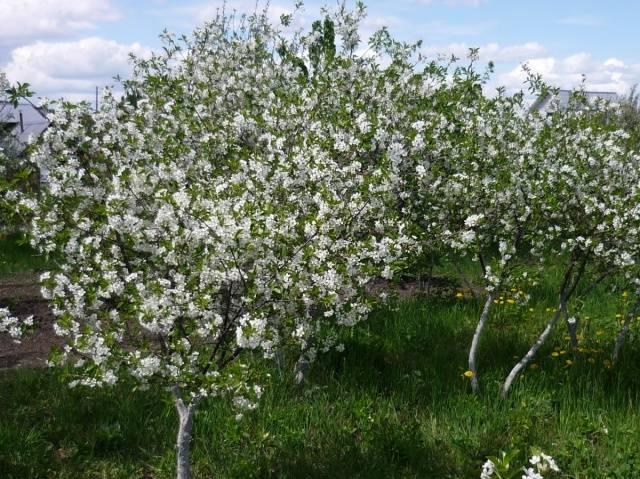

Entering fruiting
Compared to other crops (except peach), cherries begin to bear fruit early. The varieties are divided into three groups:
Fast-growing. The first crop is harvested in the third or fourth year after planting.
Medium-fruited. Fruiting - in the fourth year.
Late-fruited. Harvesting begins in the fifth or sixth year after planting.
Data are given for grafted varieties. Steppe cherry almost always begins to bear fruit earlier than ordinary cherry.
The period of full fruiting of cherries, depending on the variety, begins at 8-12 years of age.
Cherry sizes
By size, cherry varieties are also divided into three groups:
Stunted. A tree, or more often a bush, whose height does not exceed 2 m.
Medium-sized. The plant is 2-4 m high.
Tall. Cherry, the height of which reaches 6-7 m or more.
Plant size is not constant. With poor care, the cherry will be below the declared size, and with an excess of nitrogen fertilizers, it will be higher. And in fact, and in another case, the yield and quality of the fruits will suffer.
Harvest time


With this, everything seems to be clear. The varieties are:
Early ripe. Begins to bear fruit in late June - early July.
Mid-season. The crop is harvested in July.
Late ripening. Cherries ripen in August.
Remember, the further south the region is, the earlier the cherry ripens.
Purpose of fruits
Cherry varieties are divided into three groups:
Technical. Usually they have small sour berries with a high content of vitamins and other useful elements. Eating them fresh is a dubious pleasure. But these cherries make the best jams, juices, and wines.
Universal. Berries are suitable for processing and fresh consumption.
Canteens. They are often called dessert. The fruits are very beautiful and tasty, they contain a lot of sugar and little acid. Such cherries are good to eat fresh, but the processed products from them are mediocre. They are distinguished by a "flat" taste and weak aroma.
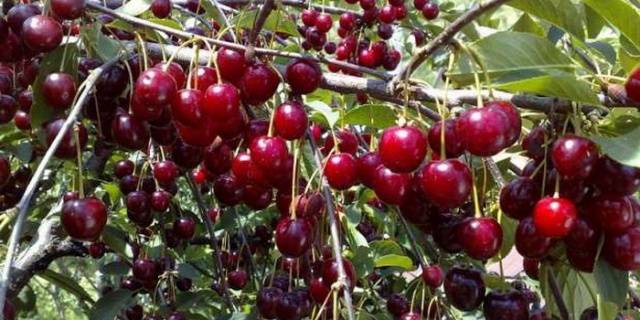

Cherry woody shape
The cultivated cherry is divided into two groups according to the shape of the plant:
Shrub. It combines steppe cherry and those ordinary varieties that grow in the form of a multi-stemmed low bush. Usually this group is more resistant to frost than the tree group. It bears fruit mainly on last year's shoots.
Tree-like. It combines most varieties of common cherries. Forms one trunk and bears fruit mostly on bouquet branches, less often on annual shoots. Drought-resistant.
Features of the fruit
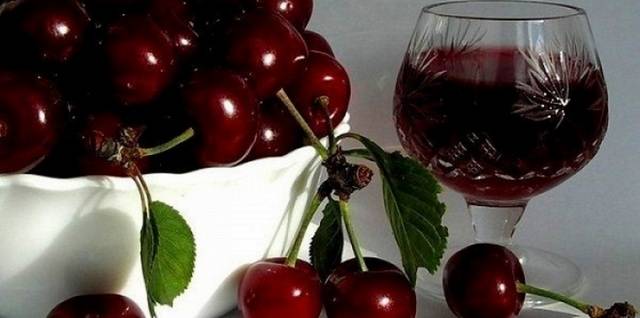

Cherry fruits are divided into two unequal groups:
Morels or griots. The juice of most varieties of steppe and common cherries is colored deep red. It stains hands, has a pronounced aroma and sourness noticeable even in table varieties.
Amoreli. Cherry varieties with pink fruits and light juice. They are much smaller and sweeter.
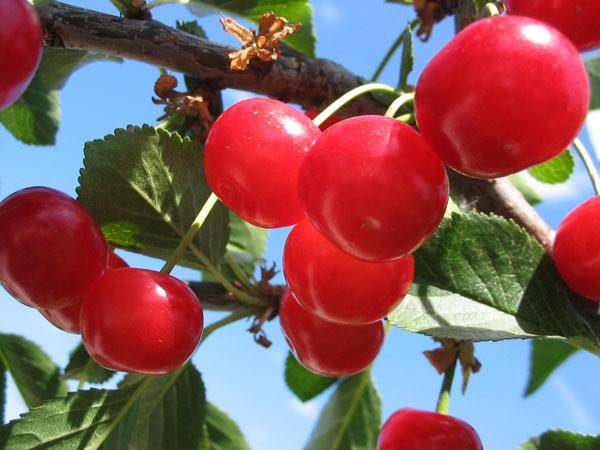

A short dictionary of hybrids
Lately, many hybrids have been created. Last but not least, this is due to the desire to develop cherry varieties that are resistant to diseases, capable of withstanding severe frosts. In addition, residents of cold regions do not give up the hope of getting cherries suitable for growing in the North into their gardens.
Duke. A hybrid of cherry and sweet cherry.
Cerapadus. A hybrid of cherry and bird cherry Maak, where the mother plant is cherry.
Padocerus. The result of crossing cherry with bird cherry, mother plant - bird cherry Maak.
Shpanka Bryanskaya - seventh place
A medium-sized tree with a short trunk and a rounded crown will delight you with fruits weighing 4 g. The cherry skin is light red, the flesh is creamy, pink juice with a sweet and sour taste. The stone is well separated from the pulp, the taste of the fruit is not lost during canning.
When ripeness is reached, the fruits practically do not crumble, which makes it convenient to grow cherries in summer cottages.


The variety is self-fertile, early, resistant to diseases and frost. In the register for the Central region. Suitable for growing in the Moscow region.
Brunette - fourteenth place
The tree is medium-sized, has a spreading shape, therefore it is inconvenient for cultivation in industrial gardens. Enters fruiting late, 6 years after planting. Fruits are about the same size, medium, dark red, almost burgundy. The pulp is firm, sweet, with a noticeable sour taste.
The main purpose is processing and conservation, but it can be eaten fresh.


Of the advantages of the Brunetka variety, gardeners note high resistance to coccomycosis.In addition, ripe fruits firmly adhere to the stalks, do not crumble.
Cherry tree propagation
The seed propagation method for cherries is very rarely used. Several other ways are acceptable for this type of fruit crops:
- Cuttings. Choose the strongest trees from which the material is taken. Use green shoots located on the south side of the tree. It is best to harvest cuttings before the onset of hot days, at the end of June. The upper part is removed from the cut shoots, and a 10-12 cm long stalk with well-developed four leaves is formed from the remaining branch. The material is planted in a box, deepening it by 3 cm.The distance between the cuttings should be at least 7 cm.
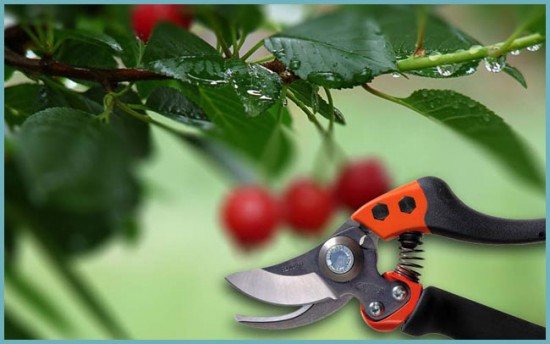

Cutting is a common way of propagating cherries
- Root shoots. From the stem of the mother plant, at a distance of 1 m, it is necessary to dig out the root cutting. Having tilted it a little, they add it in. After a while, a young shoot appears on it. After the plant is formed, it can be planted in the garden area.
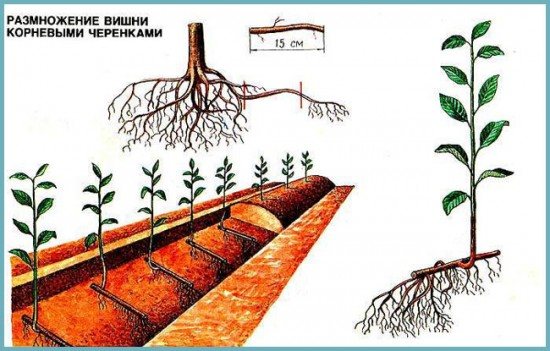

Cherry propagation by root cuttings - Graft. The rootstocks specially grown from seeds are grafted onto a young tree in several ways:
- in the side cut;
- for the bark;
- cleavage.
Abundant - ninth place
Cherry shrub-shaped, up to 1.5 meters high, with a hemispherical crown. Plant this variety and get your first harvest in 3 years. The fruits are small, the mass does not exceed 3.6 g. The peel of the cherries is red, and the flesh is creamy pink, quite juicy, sweet with a sour taste.
The yield of the variety is average, ripens by the end of July. Resistance to coccomycosis is high, to moniliosis - good.


The variety is intended for cultivation in the Middle Volga region, but also in other areas of central Russia it feels good.
Climatic conditions of the region
The Moscow region is characterized as not a very successful region for growing fruit and berry crops. But, nevertheless, thanks to the efforts of breeders, cherry varieties adapted to the climatic characteristics of the region are being developed. Summer residents living in this region can grow their own berries without much effort.
Planting in open ground involves the choice of such tree varieties that are not afraid of the cold, weather changes and other conditions that are not most favorable for the growth of a young plant.
The climate of the region is characterized as follows:
- Temperature difference. High in summer and low in winter.
- Very coldy. In the cold season, the frost reaches -35 ⁰С.
- Snowless winters. The absence of snow in winter leads to the freezing of unadapted plants.
- Change of weather. Hot days give way to relatively cool ones.
To choose a variety for planting in this region, it is necessary to study well the characteristics and description of the species. Only then make a final decision.
What are self-fertile and self-pollinated varieties
In the description of cherry varieties, there are the concepts of self-fertile, partly self-fertile and self-fertile. In self-fertile varieties, about 40% of the flowers are fertilized. In partially self-fertile varieties, this figure is not higher than 20%. Self-fertile varieties of cherries in the absence of pollinators can give no more than 5% of the ovary of the total number of flowers.
For fertilization, the flower needs to get staminate pollen on the stigma of the pistil. Mechanically, the transfer of pollen can be carried out by means of insects, wind, with the participation of humans or without intermediaries in self-pollinated plants. In this case, pollination occurs within a single flower or plant.
Plants are at a disadvantage during self-pollination, since in fact the genetic information remains almost unchanged. The main qualities for survival - variability and adaptability, are obtained by cross-pollination due to various combinations of parental genes. To protect plants from degeneration during evolution, special defense mechanisms have been developed.As a rule, in flowers, the filament is shorter and the stigma of the pistil is located much higher than the anthers. In addition, pollen, even when it hits the pistil, is not able to germinate on its own plant and cannot fertilize the ovary. Hence the definition of "self-infertile".
Self-infertile varieties need the neighborhood of other varieties of cherries and even sweet cherries. At the same time, other trees of their kind will also not be pollinators.
Self-fertile cherries differ in the structure of the flower: the anthers of the stamens are at the level of the stigma of the pistil or slightly rise above it.
The anthers of the stamens of self-fertile cherry varieties rise slightly above the stigma of the pistil
The advantage of self-fertile varieties is that you can limit yourself to one tree within the garden area. Some independence from weather conditions and pollinating insects, as well as the small size of the trees, distinguish these varieties favorably. Gardeners and experts note that with pollinating trees growing nearby, the yield of self-fertile varieties increases significantly. And you should also pay attention to the taste. As a rule, self-fertile cherries have a pronounced sourness, and sometimes they can be consumed altogether only after processing.

